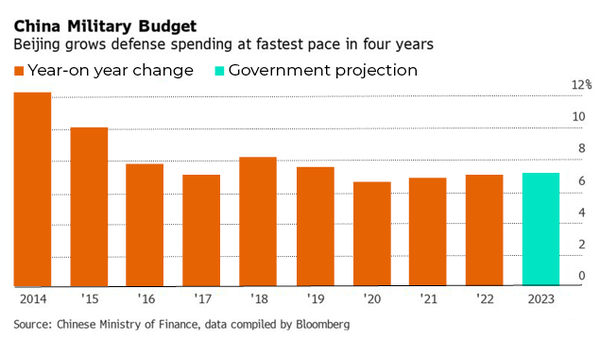China is set to increase its military spending to about $225 billion this year, a 7.2% hike compared to 2022 and the quickest rate of increase since 2019, amid rising tensions with the US and its neighbours over Taiwan, the disputed South China Sea and control of the Indo-Pacific region.
Spending on the PLA has increased by at least 6.6% each year for the past three decades, and Beijing has been busy adding a slew of new hardware, including aircraft carriers, submarines and stealth fighters, apart from modernising its roughly 2 million active military personnel.
It is widely understood that Beijing spends much more money on its military than the official figures. However, China’s defence spending pales in comparison with the United States, which has allotted over $800 billion for its military this year.
Some of the ways China is enhancing its defence capabilities
- Increasing military spending: China has consistently increased its military budget. This has allowed for the development of new technologies and the acquisition of advanced weaponry.
- Modernising its military: China has been focusing on modernising its military, which includes upgrading its weapons and equipment, improving logistics and transportation capabilities, and enhancing its cyber and space capabilities.
- Developing new technologies: China has been investing heavily in developing new technologies, such as artificial intelligence and quantum computing. These technologies can be applied to military operations and give China an edge in warfare.
- Expanding its naval capabilities: China has been rapidly expanding its naval capabilities, including the development of new aircraft carriers, submarines, and other advanced naval vessels. This has allowed China to project its power further into the Indo-Pacific and other regions.
- Building military bases: China has been building military bases in strategic locations around the world, including in the South China Sea, Africa, and the Middle East. These bases can be used for logistics and support, as well as for projecting military power.
Overall, China’s ramping up of its defence capabilities is a major concern for many countries, particularly its neighbours in the Indo-Pacific region. The continued growth of China’s military has already put Taiwan, which Beijing views as its territory, on red alert.
Taiwan defence Minister Chiu Kuo-cheng recently said that the self-ruled island has to be on alert this year for a “sudden entry” by the Chinese military into areas close to its territory amid rising military tensions across the Taiwan Strait.
In-depth look at China’s military
The PLA has around 2 million trained men and women on active duty, making it the world’s largest armed force.
Ground troops make up the bulk of the army with 965,000 soldiers, while the navy has 260,000 members and the air force 395,000. There is also a strategic missile force of 120,000 and a paramilitary arm with 500,000 soldiers.
In 2019, Beijing removed nearly 300,000 soldiers from its army while pouring billions of dollars into defence modernisation. It plans to complete those efforts by 2035, and to transform the military into a “world-class” force rivalling those of the US by 2050.
China has the largest navy in the world in terms of number of vessels, but the fleet contains many smaller warships, including frigates and corvettes.
Beijing has three aircraft carriers, but only two are operational, with the third still in testing. The United States has 11 aircraft carriers.
The Pentagon in November said China’s air force was “quickly catching up with” Western ones. Within the last three years, annual production rates of both the J-16 and J-20 (fighter jets) have likely doubled.
China also has a large stockpile of missiles, along with stealth aircraft and bombers capable of delivering nuclear weapons, as well as nuclear-powered submarines.
Beijing has about 350 nuclear warheads, far fewer than the 5,428 held by the US or the 5,977 owned by Russia. China’s nuclear stockpile is expected to increase to about 1,500 warheads by 2035, the Pentagon said last year.
Beijing tested a nuclear-capable hypersonic missile that circled the globe in August 2021 and caught US intelligence by surprise.
Where India stands
India still has quite a lot of ground to cover in catching up to China and the US.
Though India has 1.4 million active personnel with another 1.1 million in reserve, its defence budget is just a third of what China spends and a tenth of the US.
India has around 2,000 aircraft out of which 577 are fighter planes, China has over 1,000 fighter planes. Beijing is way out in front in terms of attack helicopters with 280 compared to India’s 36. The countries are almost neck to neck in regards to number of tanks.
China’s naval power outstrips India on almost all fronts except aircraft carriers where both countries currently have two.
However, with renewed focus on self-reliance and indigenous development of weapons, aircraft and military technology, India may close the gap in the next few decades.
(With inputs from agencies)
